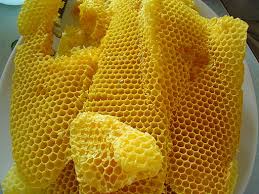Young workers between 12 and 18 days produce wax. Then the wax glands wither away.
Honeycomb is easily affected by the wax moth. The larvae that develop from her eggs, eat wax. Therefore store combs in a tight-fitting closet or suitcase.
After three years brood combs are dark and they need to be replaced. We melt them in a hot water bath, or by means of steam or a solar wax melter.
 Wax, beeswax, honeycomb are names for the plates that bees use to deposit pollen, honey and / or eggs. Filled cells are sealed with a wax lid.
Wax, beeswax, honeycomb are names for the plates that bees use to deposit pollen, honey and / or eggs. Filled cells are sealed with a wax lid.
The color of beeswax varies with the flower species visited by bees but also darkens when it becomes older.
The tubes consist of contiguous hexagonal cells. This is the most efficient format, wherein with the minimum on wax the largest useful capacity and stability is obtained.
The dimensions of a cell in a honeycomb vary between 2 and 5 mm.
Types of wax
Wax is an biological -organic substance which consists of esters of wax alcohol (higher alkanols and diols) and wax acids (carboxylic acids and fatty alcohols).
Wax is greasy, malleable, immiscible with water (hydrophobic) and has a (relatively high) melting point. It is used for candles, shoe polish, cosmetics, lubricants.
In addition to beeswax, there is Carnauba wax. That is tan and is extracted in northeastern Brazil from the leaves of the carnauba palm (Copernicia prunifera).
Shellac (wax) is recovered as the resinous secretions of the small lacquer louse (tree lice, Coccus laccase or laccase Laccifer). This wax (see elsewhere) is mainly used in the food industry as a glazing agent E904.
Candelilla wax is a hard brown to yellowish brown vegetable wax, which melts at 70°C. In water, it is virtually insoluble. It is obtained by boiling leaves of the Mexican shrub Candelilla (Euphorbia antisyphilitica and Pedilanthus pavonis) with sulfuric acid. The name still tells us that candles were made of it.
The wax is used in chewing gum and to make tents waterproof.
Vaseline is a mineral wax.
Make a furniture wax
Wax is readily soluble in turpentine (not (white) spirit), ether, chloroform, gasoline.
A basic recipe is: scrape or grate 5 parts of beeswax in 2 parts of turpentine, and stir into a paste. You can make it easier by heating it "au bain-marie".
There are many variations and additions possible: 1% soda (whitens), cayenne pepper (would combat woodworm infestation), other waxes, lemon oil, linseed oil, water, soap, fat ...
(and other waxes such as pine oil (from pine), carnauba wax (leaf wax from a fan palm (Copernicia cerfifera) in Brazil, and petroleum derivatives.)
As gum Greeks used the aromatic resin from the evergreen mastic tree (Pistacia lentiscus). It was also used as a filler and in varnish.
Other cultures use (d) fir sap, whether or not together with beeswax.
Other light stimulant chewing resources
Qat (khat or even miraa) the leaf of the Catha edulis is a light stimulant drug. Chewing the leaves dispels fatigue and hunger.
On the Thai countryside or amongst the mountain people women and men chew a reddish
teeth depleting betel nut, the seed of the betel palm (Areca catechu).
In the Andean region coca leaves (Erythroxylum coca) are chewed as a remedy for altitude sickness and as an stimulant for workers in the mining industry. It increases endurance, improves breathing and oxygen metabolism, and regulates the use of glucose.
Chewing tobacco is chopped tobacco that is chewed and spat out afterwards.
